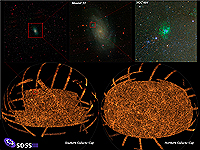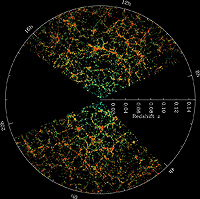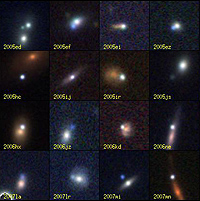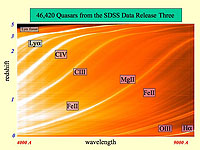
| SDSS Classic |
| SDSS.org |
| SDSS4.org |
| SDSS3.org |
| SDSS Data |
| DR19 |
| DR17 |
| DR10 |
| DR7 |
| Science |
| Press Releases |
| Education |
| Image Gallery |
| Legacy Survey |
| SEGUE |
| Supernova Survey |
| Collaboration |
| Publications |
| Contact Us |
| Search |

The SDSS Science Legacy
The final data set from SDSS-I/II contains over 12,000 square degrees of imaging (8400 square degrees in the Legacy Survey, 3500 square degrees in SEGUE, and supplementary imaging of M31 and additional low Galactic latitude fields). The catalog derived from these images includes more than 350 million celestial objects. The 300 square degree Southern Equatorial Stripe was scanned more than 20 times in SDSS-I and more than 40 times in the SDSS-II supernova survey. The final data set also includes spectra of 930,000 galaxies, 120,000 quasars, and 460,000 stars. The data, fully calibrated and reduced, carefully checked for quality, and accessible through efficient databases, have been publicly released in a series of annual data releases, culminating in SDSS DR7.
SDSS data have supported an enormous range of scientific investigations by astronomers around the world. A good popular introduction to SDSS science (especially the cosmological questions that provided much of the original motivation for the SDSS) can be found in the American Museum of Natural History Science Bulletin.
Here we list some highlights among the many discoveries made by the SDSS. In some cases, these discoveries emerged over the course of multiple investigations spread over several years; here they are listed roughly in chronological order of the first investigations. Images and plots that illustrate some of these discoveries can be found in the image gallery. Some results are linked to related SDSS press releases. Since the final SDSS datasets are only now being analyzed for the first time, the list of scientific highlights continues to grow.
-
The discovery of the most distant quasars, powered by
supermassive black holes in the early Universe:
These systems
are remarkable in themselves, and by illuminating their surroundings
they allow us to probe the transition from a Universe filled with
neutral hydrogen to an ionized Universe filled with protons
and free electrons.
Related Press Releases:
Scientists of Sloan Digital Sky Survey Discover Most Distant Quasar
Sloan Digital Sky Survey Finds Most Distant Object Ever Observed
First Light: Astronomers Use Distant Quasar to Probe Cosmic "Dark Age"
Three Distant Quasars Found at Edge of the Universe -
The discovery of large populations of sub-stellar objects:
At the opposite extreme from quasars, the SDSS discovered large numbers of
"failed" stars, not massive enough to ignite nuclear fusion
in their cores. Together, the SDSS and the Two-Micron All Sky
Survey (2MASS) have produced the main data samples for systematic
studies of sub-stellar objects.
Related Press Release:
Sky Survey Scientists Discover New Celestial Dwarfs - Mapping extended mass distributions around galaxies with weak gravitational lensing: Galaxies are surrounded by "halos" of dark matter, but prior to the SDSS the extent of these halos was inferred only indirectly. Analyses of the SDSS used the subtle gravitational distortion of the shapes of background galaxies to demonstrate that dark matter halos typically extend to nearly a million light years).
-
Systematic characterization of the galaxy population:
By providing high quality images, distances, and stellar masses and
ages of hundreds of thousands of galaxies, the SDSS transformed
the study of galaxy properties and the correlations among them
into a precise statistical science, yielding powerful insights
into the physical processes that govern galaxy formation.
Related Press Releases:
Link between Black Holes and Galaxies Discovered in Our Own Backyard
New Metal-poor Galaxies: The Youngest in the Universe?
Sloan Digital Sky Survey Findings Comprise New Compendium of Galaxy Families
The Galaxy Zoo Welcomes a Flood of Visitors -
The demonstration of ubiquitous substructure in the outer Milky Way:
SDSS maps of the distribution of stars show that the stellar halo of
the Milky Way is filled with complex substructure, probably
a signature of its hierarchical buildup from smaller components.
SDSS and SEGUE data show that the motions of stars are correlated
with their chemical compositions, providing further evidence that
today's stellar halo is a mixture of distinct families of stars.
The SDSS has also identified thousands of the most chemically
primitive stars in the Galaxy, which provide insight into the
first epochs of cosmic star formation.
Related Press Releases:
Researchers Say New Star Structures Found in the Milky Way Alter Galactic Model
The Sloan Digital Sky Survey Reveals a New Milky Way Neighbor
Multiple galaxy mergers continue in the Milky Way
The Milky Way Has a Double Halo
New Milky Way Map Reveals a Complicated Outer Galaxy - Demonstration of the common origin of dynamical asteroid families: Through the identification of moving objects in the imaging data, the SDSS has greatly increased the number of known asteroids and provided precisely measured colors for them. These data give an improved determination of the asteroid size distribution, and they show that the members of dynamical families also have distinctive colors, demonstrating their common origin.
- Precision measurement of the luminosity distribution of quasars: The SDSS has precisely mapped the rise and fall of the population of quasars, the most luminous objects in the Universe, and thus the growth of the supermassive black holes that power them.
-
Precision measurements of large scale clustering and
cosmological constraints:
The precise clustering measurements, made
possible by the enormous size and high completeness of the
SDSS galaxy maps, provide powerful
constraints on the matter and energy contents of the Universe
and on the nature and origin of the primordial fluctuations
that seeded the growth of cosmic structure.
Related Press Releases:
3D Map of Universe Bolsters Case for Dark Energy and Dark Matter
How Big is Big? Probing the Conditions of the Universe on the Largest Scales -
Precision measurement of early structure with the
Lyman-alpha forest:
Each SDSS quasar spectrum maps the distribution of absorbing
hydrogen gas along its line of sight (the "Lyman-alpha forest").
The enormous numbers of SDSS quasars have made it possible to
measure the clustering of the underlying dark matter distribution
with high precision, at epochs when the Universe was only 10% to 25%
of its present age.
Related Press Release:
Cosmic Clumping -
Detailed characterization of small and intermediate scale
clustering of galaxies:
On scales of tens of thousands to tens
of millions of light years, the SDSS galaxy maps allow precise
measurements of the clustering of many different classes of
galaxies (defined by luminosity, age, shape, and other properties).
These in turn allow strong tests of galaxy formation theories
and statistical determination of the relation between galaxies and dark
matter halos.
Related Press Release:
Cosmic Voids were Emptied by Gravity -
Discovery of many new companions of the Milky Way and Andromeda:
Careful analyses of the SDSS stellar maps have revealed nine new
dwarf galaxy companions of the Milky Way, nearly equal to the number
found in the previous 70 years, as well as two new companions of the
Andromeda galaxy. These discoveries transform the status
of the ``missing satellite problem,'' which is one of the key
challenges in understanding galaxy formation in a dark matter
dominated Universe.
Related Press Releases:
Could Galactic Find be Andromeda's Food?
Andromeda 9 - The Faintest Galaxy Ever
Sloan Digital Sky Survey Finds Mysterious New Milky Way Companion
New Milky Way companions found
Sloan and the Seven — Make That Eight — Dwarfs - Discovery of stars escaping the Galaxy: A small number of stars in the Galactic halo have velocities close to, or exceeding, the escape speed. These stars have likely been ejected by violent gravitational encounters with the supermassive black hole at the Galactic Center. They provide information on the conditions at the Galactic Center and on the shape, mass, and total extent of the Galaxy's dark matter halo.
-
Discovery of acoustic oscillation signatures in the clustering of
galaxies:
The SDSS achieved the first clear detection of this long-predicted
cosmological signal, an effect of sound waves that travel in the
hot early universe and imprint a characteristic scale on the
distribution of galaxies. This discovery opens
the door to a new method of cosmological measurement that
is the key to BOSS, the largest survey of SDSS-III.
Related Press Release:
The Cosmic Yardstick -
Measurements of the clustering of quasars over a wide range
of cosmic time:
The enormous size of the SDSS quasar catalog
allows measurements of the large scale structure of the Universe
that reach to great distances and therefore probe early times.
Recent measurements show that the most distant quasars cluster
much more strongly than nearby systems, implying that they reside
in massive concentrations of dark matter.
The measurements are also being used to test models of the
growth and fueling of the supermassive black holes that power
the quasar population.
Related Press Release:
Distant Quasars Live in Massive Dark Matter Halos
Half of these achievements were among the original "design goals" of the SDSS, but the other half were either entirely unanticipated or not expected to be nearly as exciting or powerful as they turned out to be.
The SDSS has also played a major role in training new generations of outstanding scientists. More than 70 PhD theses based on SDSS data were completed under the supervision of SDSS participants (and probably many more with public data).
As of September 2008, SDSS data have contributed to more than 2000 articles in refereed journals, with more than 70,000 citations.

|
|
|

|
|
|

|
|
|

|
|
|

|
|
|

|
|
|